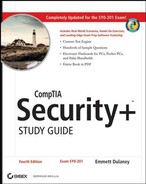W
- WAN
See wide area network (WAN).
- war driving
Driving around with a laptop looking for open wireless access points with which to communicate.
- warm site
A site that provides some capabilities in the event of a disaster. The organization that wants to use a warm site will need to install, configure, and reestablish operations on systems that might already exist in the warm site.
- weak key
A cipher hole that can be exploited.
- weak key attack
An attack that looks for cipher holes.
- web proxy
A type of proxy that is used to act on behalf of a web client or web server.
- web server
A server that holds and delivers web pages and other web content using HTTP. See also Hypertext Transfer Protocol (HTTP).
- WEP
See Wired Equivalent Privacy (WEP).
- wide area network (WAN)
A network that crosses local, regional, and/or international boundaries.
- Wi-Fi
See Wireless Fidelity (Wi-Fi).
- Windows Internet Naming Service (WINS)
A Network Basic Input Output System (NetBIOS) name resolution service employed in Windows networks. Windows Internet Naming Service (WINS) translates hostnames into network addresses.
- Windows NT service
A type of Windows program (a file with either an .exe or a .dll filename extension) that is loaded automatically by the server or manually by the administrator.
- Windows socket
A Microsoft API used to interact with TCP/IP.
- WinNuke
A Windows-based attack that affects only computers running Windows NT 3.51 or 4. It's caused by the way the Windows NT TCP/IP stack handles bad data in the TCP header. Instead of returning an error code or rejecting the bad data, it sends NT to the Blue Screen of Death (BSOD). Figuratively speaking, the attack "nukes" the computer.
- Wired Equivalent Privacy (WEP)
A security protocol for 802.11b (wireless) networks that attempts to establish the same security for them as would be present in a wired network.
- wireless access point
A wireless bridge used in a multipoint radio frequency (RF) network.
- wireless bridge
A bridge that performs all the functions of a regular bridge but uses RF instead of cables to transmit signals.
- Wireless Fidelity (Wi-Fi)
An 802.11b or 802.11g wireless network operating in the 2.4Ghz or 5Hhz frequency range.
- wireless local area network (WLAN)
A local area network that employs wireless access points (WAPs) and clients using the 802.11 standards.
- wireless portal
The primary method of connecting a wireless device to a network.
- wireless technologies
Technologies employing wireless communications.
- Wireless Transport Layer Security (WTLS)
The security layer of the Wireless Applications Protocol (WAP). WTLS provides authentication, encryption, and data integrity for wireless devices.
- WLAN
See wireless local area network (WLAN).
- work factor
An estimate of the amount of time and effort that would be needed to break a system.
- workgroup
A specific group of users or network devices, organized by job function or proximity to shared resources.
- working copy
The copy of the data currently in use on a network.
- workstation
A computer that isn't a server but is on a network. Generally, a workstation is used to do work, whereas a server is used to store data or perform a network function.
- World Wide Web Consortium (W3C)
An association concerned with interoperability, growth, and standardization of the World Wide Web (WWW). This group is the primary sponsor of XML and other web-enabled technologies.
- worm
A program similar to a virus. Worms, however, propagate themselves over a network. See also virus.
